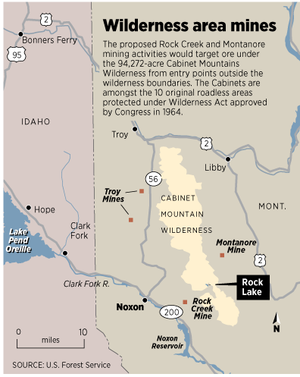Montanore study completed for mining in Cabinet Wilderness
WILDERNESS -- A proposed silver and copper mine beneath northwestern Montana’s Cabinet Mountains Wilderness cleared a significant hurdle Tuesday with the completion of an environmental study in the works for the past decade, according to an Associated Press report.
A final decision on the Montanore mine near the Montana-Idaho border could come by late January, said Craig Jones with the Montana Department of Environmental Quality. The U.S. Forest Service gave a preliminary OK in March.
Spokane-based Mines Management, Inc. is proposing to remove up to 120 million tons of ore from the underground mine, which would disturb more than 1,500 acres of land just outside the wilderness area. Included is a 14-mile long transmission line to carry power to the site near Libby, Montana.
State regulators and U.S. Forest Service officials must approve the project.
Environmental groups are strongly opposed. They sued the federal government in June over concerns that mining would harm federally-protected grizzly bears and bull trout.
The groups are particularly concerned about the potential cumulative affects of the Montanore Mine and the proposed Rock Creek Mine that would be based on the opposite side of the Cabinet Mountains Wilderness. The Rock Creek Mine project was acquired this year by Hecla Mining Co.
The Cabinet-Yaak ecosystem on the Montana-Idaho border is one of six areas in the continental United States where biologists are seeking to restore grizzly bear populations.
The U.S. Fish and Wildlife Service said last year that the mine could lead to the loss of one federally protected grizzly bear. But it said required mitigation – including the purchase of 5,000 acres of grizzly habitat at risk for development – will make up for the loss. The agency said bull trout populations also could suffer losses in certain streams close to the mine site, but not enough to threaten the species’ overall survival.
See background stories:
- Feds: Mine, grizzlies can coexist in Cabinet Mountain wilderness area
- Rock Creek Mine decision upheld; grizzlies not imperiled
- Development proposals bad news for Cabinets grizzlies
An attorney for the plaintiffs in the Montanore lawsuit – Save Our Cabinets, Earthworks and Defenders of Wildlife– said federal officials offered too little evidence to support their claims.
Here's more from the AP:
“We believe the project will jeopardize those species,” said Katherine O’Brien with the law firm Earthjustice. O’Brien said the plaintiffs would seek to halt the mine if it’s approved, until their claims are resolved.
The mine’s backers have said it would employ about 500 people during the construction phase and about 350 during mining.
Work on the mine site began around 1990 under different ownership, but was suspended in 1991 due to low metal prices. Mines Management later took over and applied to the state for a mining permit in 2004.
Earlier this year, a group of investors led by former Montana Gov. Brian Schweitzer sought $10 million from Mines Management in a federal court proceeding. Schweitzer’s group, known as Optima Inc., said it held mining rights in the area and deserved compensation.
U.S. District Judge Dana Christensen rejected Optima’s arguments, saying its mining claims had no value. An appeal is pending.
Environmental activists say the root of the problem is an outdated 1872 mining law that needs reform to protect wilderness values.
